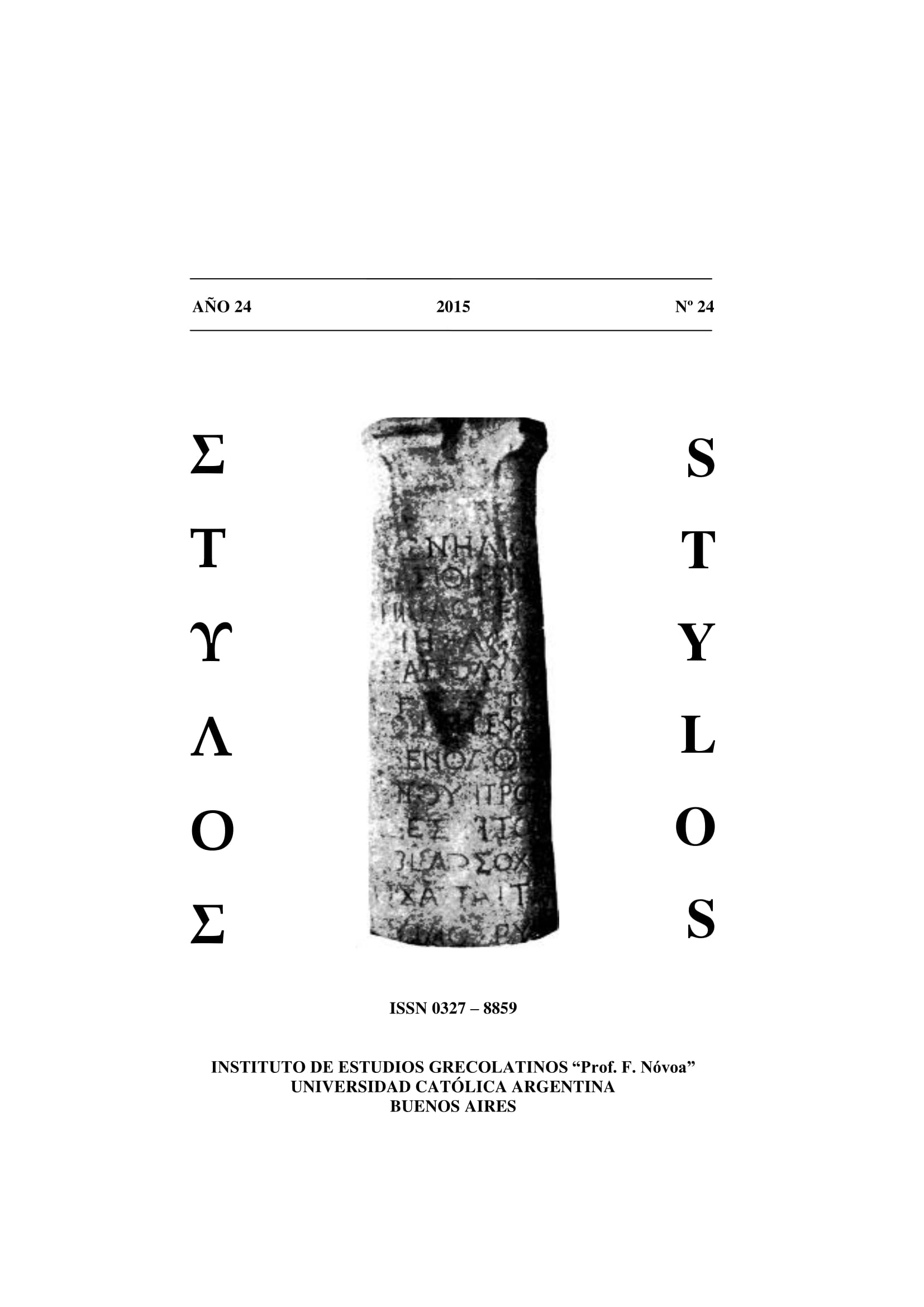LA METÁFRASIS BIZANTINA COMO FORMA DE INTRA-TRADUCCIÓN. EL CASO DE LA VIDA DE ESPIRIDÓN
Keywords:
hagiographie – Léonce de Néapolis – metáphrasis – traduction - ByzanceAbstract
Le présent travail étudie le cas de la Vie d’Espiridon, que nous attribuons à Léonce de Néapolis, et d’autres versions du texte qui constituent des metaphráseis. On propose le concept de ‘intra-traduction’ pour le travail qui implique mettre à un niveau de langue accessible pour un public plus grand cela qui était difficile à cause de son niveau linguistique, rhétorique ou poétique; mais ce travail ne passe pas le texte d’un code à un autre, d’une langue à une autre. Ici on fait l’analyse de l’oeuvre de Léonce et de ses adaptations comme une ‘intra-traduction à l’inverse’, parce que celles-ci essayent de faire plus littéraire et plus cultivé le niveau de la langue de l’oeuvre originelle. Ce type de travail est une ‘adaptation’, une ‘récréation’ plus qu’une traduction; c’est la tâche d’une personne qui refait la chose; qui, à l’intérieur d’une même langue, fait des modifications relatives à le style, à l’intentionnalité et, peut-être encore, à l’idéologie.Downloads
References
BÁDENAS, P. (1996): “Metáfrasis en griego vulgar de la Historia de Barlaam e Josafat”, en J. Egea-J. Alonso eds. Prosa y verso en griego medieval, Amsterdam, Hakkert, 59-73.
BRIESEMEISTER, D. (1980): “Die Theorie der Übersetzung in Spanien im 15.Jahrhundert”, en Stimmen der Romania, Wiesbaden, 483-517.
BROWN, P. (1983): “The saint as exemplar in Late Antiquity”, Representations 3, 1-25.
BROWNING, R. (1981): “The ‘low level’ saint’s life in the early Byzantine world”, en S. Hackel ed. The Byzantine saint, London, Saint Vladimir Seminary Press, 117-127.
CAPES, D. (2003): “Imitatio Christi and the Gospel genre”, Bulletin for biblical research 13/1, 1-19.
CAVALLERO, P. (1986): "La adaptación poética de los Moralia in Iob de San Gregorio en el Rimado de Palacio del Canciller Ayala", Hispania Sa-cra 38, 401-518.
CAVALLERO, P. (1991): Del soberano bien": romanceamiento castellano medieval de las "Sententiae" de San Isidoro, edición crítica con intro-ducción y notas. Buenos Aires, SECRIT-CONICET (Incipit, Publica-ciones 3).
CAVALLERO, P. (2008): “El griego en el latín de Liutprando, el latín en el griego de Leoncio”, en A. Fraboschi ed. Grecia en la Latinidad: actas de las XIV Jornadas de Estudios Clásicos, Buenos Aires, Instituto Nó-voa, UCA, 2008, 71-80.
CAVALLERO, P.-FERNÁNDEZ, T.-LASTRA SHERIDAN, J. (2009): LEONCIO DE NEÁPOLIS, Vida de Simeón el loco, edición revisada, con introducción, traducción y notas Buenos Aires, Sección Filología Medieval del Instituto de Filología Clásica, FFyL, UBA.
CAVALLERO, P. -UBIERNA, P. et alii (2011): LEONCIO DE NEÁPOLIS, Vida de Juan el limosnero, edición revisada, con introducción, traducción y notas por P. Cavallero, P. Ubierna, A. Capboscq, J. Lastra Sheridan, A. Sapere, T. Fernández, S. Bohdziewicz y D. Santos. Buenos Aires, Sección Filología Medieval del Instituto de Filología Clásica, FFyL, UBA.
CHANTRAINE, P. (1999): Dictionnaire étymologique de la langue grecque, avec un supplément, Paris, Klincksieck.
DELAVENAY, É. (1972): La machine à traduire, Paris, PUF, 3e. éd.
DELEHAYE, H. (1927): “Une vie inédite de saint Jean l’Aumônier”, Analecta Bollandiana 45, 5-74.
DIMITRAKOS, D. (1951): Méga léxikon ólis tis ellinikís glóssis, Athinai, Domi.
DU CANGE, Charles du Fresne Sgr. Glassarium ad scriptores mediae et infi-mae graecitatis, Lugduni, Anissonius-Posuel-Rigaud, 1668 = Graz, 1958.
EFTHYMIADIS, S. (1991): “John of Sardis and the metaphrasis of the Passio of St. Nikephoros the martyr (BHG 1334)”, Rivista di studi bizantini e neoellenici 28, 23-44.
EFTHYMIADIS, S. (2006): “Two Gregories and three genres: autobiography, autohagiography and hagiography”, en J. Bortnes-T. Hägg edd. Gregory of Nazianzus: images and reflections, Copenhagen, Museum Tusculanum Press, 239-256.
EFTHYMIADIS, S. (2011): “Hagiography from the ‘Dark Age’ to the age of Symeon Metaphrastes (eight-tenth centuries)”, en The Ashgate re-search companion to Byzantine hagiography, vol. I, Farnham-Surrey, Ashgate, 95-142.
EHRHARD, A. (1928): reseña “H. Delehaye, Une vie inédite de Saint Jean l'au-mônier. Anal. Boll. 45 (1927) 5-74“, BZ 28, 440-441.
ERNOUT, A. - MEILLET, A. (1951): Dictionnaire étymologique de la langue latine. Histoire des mots, Paris, Klincksieck, 3e. édition.
FESTUGIERE, A.-RYDEN, L. (1974): Léontios de Néapolis, Vie de Syméon le fou et Vie de Jean de Chypre, Paris, Paul Geuthner.
GOUILLARD, J. (1941): “Syméon Logothète et Magistros, surnommé Méta-phrastes”, Dictionnaire de théologie catholique 14/2, 2959-2972.
HǾGEL, Ch. (1996): ed. Metaphrasis: redactions and audiences in Middle Byzantine hagiography, Oslo.
HǾGEL, Ch. (2002): Symeon Metaphrastes. Rewriting and canonization, Co-penhagen.
HORTAL, A. (2007): Ética profesional de traductores e intérpretes, Bilbao, Desclée de Brouwer.
JAKOBSON, R. (1975): “En torno a los aspectos lingüísticos de la traducción”, en Ensayos de lingüística general, Barcelona, Seix Barral, 67-77.
KRIARAS, E. (1971-): Λεξικό της μεσαιωνικής ελληνικής δημώδους γραμματείας 1100-1669, Tessaloniki.
LAFONTAINE, G. (1973): “Une vie grecque abrégée de saint Grégoire l’illuminateur (cod. Sin. Gr. 376)”, Le muséon 86, 135-145.
LAMPE, W. (1961): A patristic Greek lexicon, Oxford, Clarendon.
LAPPA-ZIZICAS, E. (1970): “Une épitomé de la vie de S. Jean l’Aumônier par Jean et Sophronius”, Analecta Bollandiana 88, 265-278.
LESPÉRAS, J. (1980): “La traduction et ses théories en Espagne au XVe et XVIe siècles”, Revue des langues romanes 84, 81-92.
MAGDALINO, P. (1999): “’What we heard in the Lives of the saints we have seen with our own eyes’: the holy man as literary text in tenth century Constantinople”, en J. Howard-Johnston- P. Hayward, The cult of the Saints in Late Antiquity and the Middle ages. Essays on the contribution of Peter Brown, Oxford, 83-112.
MANGO, C. (1994): “El Santo”, en G. Cavallo (comp.) El hombre bizantino, Madrid, Alianza, 319-350.
MARGOT, J. (1987): Traducir sin traicionar, Madrid, Cristiandad.
MERINO, W. (1983): “Traduttore traditore: riesgos y peligros de la traducción”, Estudios humanísticos 5, 39-54.
MONFRIN, J. (1964): “Humanisme et traducteurs au Moyen Âge”, en L’humanisme médiéval dans les littératures romanes du XIIe au XIVe siècle (Colloque Strasboug 1962), Paris, vol. 3, 217-246.
MOUNIN, G. (1977): Los problemas teóricos de la traducción, Madrid, Gre-dos, 2ª ed.
PASCHALIDIS, S. (2011): “The hagiography of eleventh and twelfth centu-ries”, en S. Efthymiadis, The Ashgate research companion to Byzan-tine hagiography, vol. I, Farnham-Surrey, Ashgate, 143-171.
PASSOW, F. (1848): A Greek-English lexicon based on the work of Francis Passow, by H. Liddell, R. Scott and H. Drisler, New York, Harper and brothers.
PEYR, E. (1992): “Zur Umarbeitung rhetorischer Texte durch Symeon Metaphrastes”, Jahrbuch der Österreichischen Byzantinistik 42, 143-155.
RAPP, C. (1995): "Byzantine hagiographers as antiquarians. Seventh to tenth centuries“, Byzantinische Forschungen 21, 33-44.
SÁEZ HERMOSILLA, T. (1980): “Pratique et théorie de la traduction”, Anua-rio de estudios filológicos 3, 203-213.
SIMPSON, A. (2013): Niketas Choniates. A historiograpjical study, Oxford, University Press.
SOPHOCLÉS, E. (1887): Greek lexicon of the Roman and Byzantine periods, Hildesheim-Zürich-New York, Georg Olms Verlag, 1992.
STEPHANUS, H. (1842-1846): Thesaurus Graecae Linguae, Paris, Didot.
STEPHOU, L. (2011): Die neugriechische Metaphrase von Stephanites und Ichnelates durch Theodosios Zygomalas, Madrid, CSIC.
STEINER, G. (1980): Después de Babel. Aspectos del lenguaje y la traducción, México, FCE.
TALBOT, A. (2011): “Hagiography in late Byzantium (1204-1453)”, en S. Efthymiadis ed. The Ashgate research companion to Byzantine hagiography, vol. I, Farnham-Surrey, Ashgate, 173-195.
TERRACINI, B. (1951): “El problema de la traducción”, en Conflictos de len-guas y de cultura, Buenos Aires, Imán, 43-103.
THÉRY, G. (1950): “Notes indicatrices pour s’orienter dans l’étude des tra-ductions médiévales”, en Mélanges Joseph Maréchal, 2: Hommages, Museum Lessianum, Section philosophique Nº 32, Bruxelles-Paris, 297-315.
TOUFEXIS, N. (2008): “Diglossia and register variation in Medieval Greek“, Byzantine and Modern Greek Studies 32/2, 203–217.
TRAPP, E. (2001): Lexicon zur byzantinistischen Gräzität, besonders des 9.-12. Jahrhunderts, Band A-K, Wien, Österreichischen Akademie der Wissenschaften.
VAN DEN VEN, P. (1953): La légende de S. Spyridon, évêque de Trimithonte, Louvain, Institut orientaliste.
VOLK, R. (2002): “Eine seltsame Metaphrase von Psellos-Briefe”, JÖB 52, 185-196.
WEST, C. (1932): “La théorie de la traduction au XVIIIe siècle”, Revue de littérature comparée XII, 330-352.
ZILLIACUS, H. (1938): “Zur stilistischen Umarbeitungstechnik des Symeon Metaphrastes”, BZ 38, 333-350.
Downloads
Published
How to Cite
Issue
Section
License






